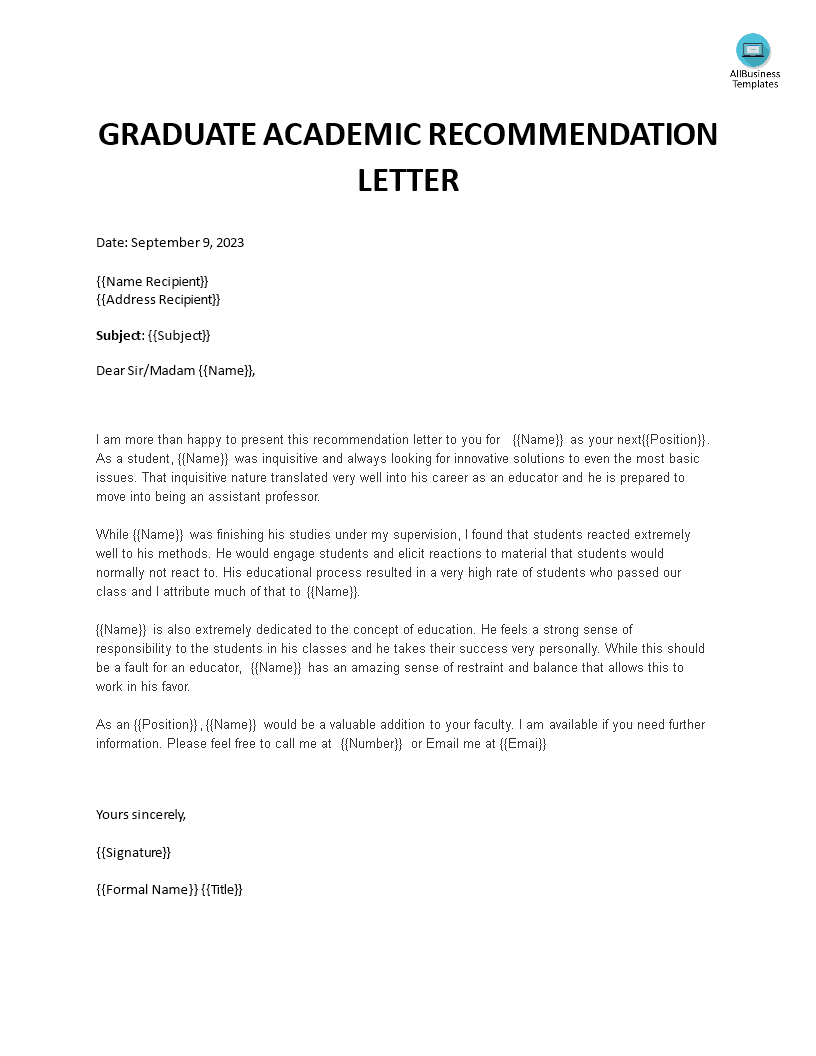Graduate Academic Recommendation Letter
Sponsored Link免费模板 保存,填空,打印,三步搞定!

Download Graduate Academic Recommendation Letter
微软的词 (.docx)免费文件转换
- 本文档已通过专业认证
- 100%可定制
- 这是一个数字下载 (24.55 kB)
- 语: English
Sponsored Link
How to write a letter of recommendation for a Graduate Academic position? Download this sample template now and use it as a guide in creating your own letter. The template contains the necessary format and structure to ensure that your letter is effective and professional.
A graduate academic recommendation letter is a document written by someone who knows a graduate school applicant well and can speak to their qualifications, abilities, and character. This letter is an essential component of the graduate school application process and is typically required by most universities and programs.
Here are some key points about graduate academic recommendation letters:
- Purpose: The primary purpose of a graduate academic recommendation letter is to provide insight into the applicant's academic and professional potential. It helps the admissions committee understand why the applicant is a suitable candidate for their program.
- Content: A well-written recommendation letter should include information about the applicant's academic achievements, research skills, work ethic, character, and any other relevant qualities that make them a strong candidate for the specific graduate program.
- Authorship: These letters are typically written by professors, advisors, employers, or other individuals who have worked closely with the applicant in an academic or professional capacity. The author should have a good understanding of the applicant's abilities and potential.
- Format: Recommendation letters are usually formal documents, and they should be written on official letterhead if possible. They are typically addressed to the admissions committee or the specific graduate program director.
- Specificity: Strong recommendation letters are specific and provide concrete examples of the applicant's achievements and qualities. Generic or vague letters are less effective.
- Confidentiality: It's important for the applicant to waive their right to see the recommendation letter. This demonstrates to the admissions committee that the letter is honest and unbiased.
- Submission: The author typically submits the recommendation letter directly to the graduate program as part of the application process. Sometimes, universities have online systems for submitting these letters electronically.
- Number of Letters: Graduate programs often specify how many recommendation letters they require. This can vary from one program to another, but it's usually around two to three letters.
- Deadlines: It's crucial for both the applicant and the letter writers to adhere to application deadlines. Late letters may not be considered by the admissions committee.
Overall, a well-written graduate academic recommendation letter can greatly enhance an applicant's chances of being accepted into their desired graduate program by providing a strong endorsement of their qualifications and potential for success in their chosen field of study.
Creating a Graduate Academic Recommendation Letter in Summary:
- Understand the Purpose and Guidelines:
- Get information about the program and guidelines.
- Understand the applicant's goals and what to emphasize.
- Gather Information:
- Review applicant materials.
- Ask for additional details about achievements and experiences.
- Format and Structure:
- Use a formal business letter format.
- Include an introduction, body, and conclusion.
- Introduction:
- Explain your relationship with the applicant.
- Mention how long you've known them and in what context.
- Highlight Academic Qualities:
- Focus on academic achievements and qualifications.
- Provide specific examples of excellence.
- Emphasize Relevant Skills and Qualities:
- Highlight skills, research abilities, and contributions.
- Mention involvement in extracurricular activities.
- Discuss Character and Work Ethic:
- Comment on their character, work ethic, and professionalism.
- Offer examples of responsibility and reliability.
- Address Weaknesses (If Applicable):
- If there are weaknesses, address them constructively.
- Explain how the applicant has worked to improve.
- Conclude Strongly:
- Summarize your endorsement and confidence in their success.
- Offer to provide additional information.
- Professional Closing:
- Use a formal closing and include your contact information.
- Proofread and Edit:
- Check for errors and ensure clarity and organization.
- Submit the Letter:
Follow submission instructions provided by the applicant or the institution.
Crafting a well-written, specific, and supportive recommendation letter can significantly aid the applicant's chances of admission to their desired graduate program.
Using this Graduate Academic Recommendation Letter template guarantees you will save time, cost, and effort! Completing documents has never been easier!
Download this Graduate Academic Recommendation Letter template now for your own benefit!
DISCLAIMER
Nothing on this site shall be considered legal advice and no attorney-client relationship is established.
发表评论。 如果您有任何问题或意见,请随时在下面发布
相关文件
Sponsored Link

